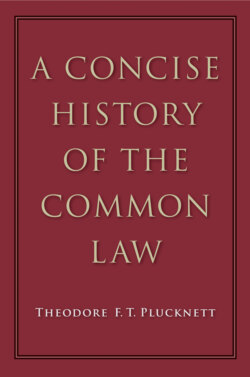Читать книгу A Concise History of the Common Law - Theodore F. T. Plucknett - Страница 93
На сайте Литреса книга снята с продажи.
THE MANOR
ОглавлениеThe manor as it existed in its typical form in the England of the thirteenth century is the product of a large number of different lines of development, some of them of very ancient date, which gradually converged to form one institution. One of its most striking features is the fact that all the tenants hold dependently of the lord of the manor. The origins of this may perhaps be sought in the tendency of small landowners to commend themselves and their land to some local magnate who seemed more likely to give them protection during such troubled times as the Danish invasions and the fairly constant wars between petty kingdoms. The weakness of the central power, too, undoubtedly promoted the growth of small local jurisdictions which were ready to undertake the task of repressing crime and organising military defence. This process was very probably hastened by the heavy burden of taxation. In many parts of the world, even to-day, it has been found necessary to curb the activities of the capitalist who takes advantage of a small landowner who is unable to meet his taxes. In pre-Conquest days no such limits were ever thought of, and it is extremely probable that a great deal of free land was converted into land dependently held under the pressure of taxation. This did not mean that the poor owner was dispossessed; the change was principally to burden him with services in money, labour or products payable regularly, in return for which the lord took upon himself the public burdens of the property. In this connection it is essential to remember that taxation in the middle ages did not usually recur at regular intervals; the small man who had little economic reserve might therefore have to meet sudden liabilities quite beyond his means, although if those liabilities had been evenly spread over a length of years they would have been much less burdensome.
These dependent tenants were, it seems, originally freemen; there is no evidence of any extensive number of slaves or bondmen in early Anglo-Saxon England. In the course of time, however, the burdens upon these tenants steadily increased; more and more labour becomes due, and the increasing arbitrariness of its exaction will emphasise the baseness of the tenure. By the time we get to Domesday Book the development of serfdom has rapidly proceeded. On many manors it seems to be completed; on others a few faint traces of freedom still remain, and this is particularly so on the vast but scattered estates of the Crown. Throughout the middle ages these “sokemen of the ancient demesne” will be accounted as slightly higher than the villeins, and centuries later we shall find ambitious bondmen having lawyers search Domesday Book for them in the hope that it may turn out that their manor once formed part of the ancient demesne of the Crown.
In the majority of cases, however, these once free tenants became servile. Besides this lordship over land there was a good deal of personal jurisdiction. There are various origins for this also. Doubts have recently been cast upon Maitland’s view that the Anglo-Saxon “sac and soc” included the right to hold a petty court, to compel tenants to attend it, and to take profits from it.1 In those cases where a manor contained freemen as well, there may have operated the universal feudal principle that every lord can hold a court for his free tenants. Where the whole area of an ancient village community had fallen into the power of a lord it was natural that he should supervise the whole business of arranging the agricultural economy of the inhabitants, for, in spite of all the feudal superstructure which the common law has erected, the foundation of the later manor is often an ancient village community.
